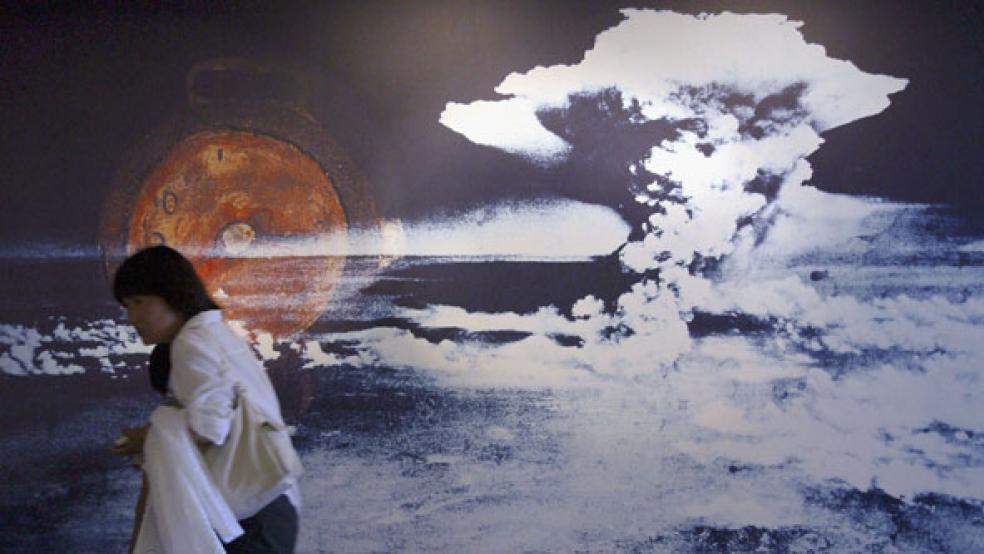HIROSHIMA – The ongoing Fukushima nuclear power plant disaster overshadowed this year’s commemoration on Saturday of the atomic bomb that obliterated this city at the end of World War II.
For the first time, Hiroshima’s mayor mentioned nuclear power in the annual proclamation, whose usual purpose is to implore world leaders to embrace nuclear disarmament. The head of the City Council declared, “Many citizens are still at risk of radiation exposure, and this disaster has confirmed our worst fears about the potential danger of nuclear energy.”
Japan is still reeling from the March 11 earthquake and tsunami-triggered meltdown at three Fukushima Daiichi nuclear reactors that exposed thousands of people to radiation and forced many from their homes. While the disaster pales in comparison to the 1945 bombings of Hiroshima and Nagasaki, today’s commemoration ceremonies were freighted with the monumental challenges facing Japan today.
Prime Minister Naoto Kan traveled from Tokyo to officially announce his administration’s new energy policy, one that echoes the decision taken earlier this year in Germany. Though nuclear power provides 30 percent of Japan’s electricity, the country will strive in the next few years “to become a society that is not dependent on nuclear power,” the prime minister told the nearly 100, 000 people who attended the solemn ceremony.
That will probably require a crash campaign to develop alternative energy sources like wind and solar power. Unfortunately, Japan’s cash-strapped government will be hard pressed to make such investments, which in any case will take time. Its 2-to-1 debt-to-GDP ratio is the highest in the world – more than twice the U.S. ratio.
Therefore, the only alternatives in the short run are conservation and rationing. The country is already getting a taste of what that means.
Long, Hot Summer in Japan
With 19 of the nation’s 54 nuclear powers plants shut down pending a two-step review by Japan’s Nuclear and Industrial Safety Agency, this nation of 125 million people is sweltering its way through a long, hot summer. The government has requested a 10 percent reduction in electricity consumption to avoid blackouts.
Public reminders of the campaign are everywhere. Commuters are no longer greeted by a welcome blast of cold air when they enter subway cars. Office workers sweat their way through the day in shirtsleeves and no ties. Hospitals have stopped air conditioning non-medical spaces like hallways and waiting rooms.
Despite the hardships, Japanese public opinion shows no signs of reversing the post-Fukushima swing against nuclear power. “Before Fukushima, I thought nuclear power was a necessary thing. We are a country without resources and without it we couldn’t supply enough electricity,” said Kayoko Hatsumoto, a 40-year-old researcher at a law firm as she handed out flyers at the edge of the crowd. “But now, we need another method of producing electricity. It doesn’t have to be nuclear.”
Anti-nuclear bomb marchers every year march through this city on August 6th to remember the 140,000 civilians killed by the blast more than 65 years ago and to honor the tens of thousands of hibakusha, or atomic bomb survivors, whose lives were cut short by increased rates of cancer. This year, there were new slogans on their banners, illustrated by nuclear power plant symbols overlaid by a red circle with a line through it.
Local symposia that usually focus on the horrors of nuclear war also added nuclear power to their agendas. At the downtown YMCA, more than 200 people gathered to hear Keiji Kobayashi, a former instructor at Kyoto University Research Reactor Institute who has turned whistleblower and become one of Japan’s leading nuclear critics.
“They claim they have no responsibility because it was a natural disaster that couldn’t be anticipated,” he told the assembly. “But that’s not true. Two years ago, the government reviewed the earthquake standards for every nuclear plant, and the investigator at Fukushima pointed out that in 869 A.D. there was a tsunami after an earthquake that was even higher than this year’s tsunami.
“Experts just don’t want to imagine the unimaginable,” he continued. “How can they say this was an unexpected event?”
The government’s bumbling campaign to restore faith in the nation’s aging nuclear power plants has backfired badly. In recent weeks, the press has exposed secret efforts by officials of the Ministry of Economy Trade and Industry to encourage electricity company officials to send their employees into public forums to tout plant safety.
Last week, the three top officials at the ministry were fired, including the head of the nuclear safety agency. But they were immediately replaced by their second-in-commands – the standard practice in Japanese government bureaucracies. The Yomiuri Shinbun, Japan’s largest newspaper, reported Friday that the new officials are just as pro-nuclear as the men they replaced.
One of those rigged meetings took place on Japan’s southern-most major island, which houses two aging nuclear power plants that have been shuttered for inspection. “People always assumed that nuclear power plants were safe, but that assumption was totally destroyed by the earthquake,” said Ikuo Kabashima, the governor of Kumamoto Prefecture, which is adjacent to one of the plants. “In Japan, there will never be another nuclear plant built again, so the number will inevitably go down as they age.”
In an interview with The Fiscal Times, the Harvard-trained political scientist, who ran three years ago as an independent and won the governorship in his first try at elected office, said he was doing what he could at the local level to spur the development of alternatives. That includes offering incentives to a local solar manufacturer and encouraging local businesses to install rooftop solar cells.
“It’s going to take time, and it’s not as effective in terms of size,” he said. “Right now the national government is at a loss as to what to do, and the local government doesn’t know how to do it.”





